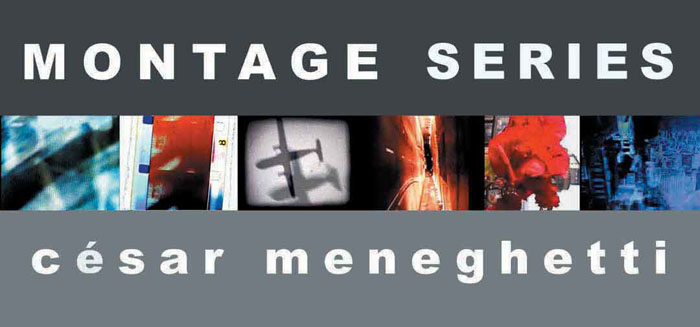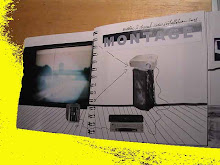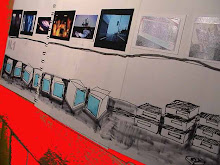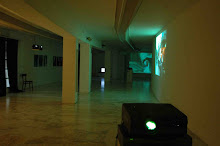MONTAGE N.1 flashback
In this first chapter “flashback”, meaning a visual emission of the past in the present, the cinematographic significance of this term mix with the time space perception, memory e travel. The observation point of view and its own subject: the city of São Paulo, Brazil.
The first seconds of the video are extracted from the film “Limite” (by Mario Peixoto, 1930): the film visibly damaged flows in parallel with the subject view of a traveller. (super-8 original footage). The road that leaves to the Guarulhos International Airport, in São Paulo; the day that the author left Brazil in 1987. Vision e passages that overlap one each other among reality and memories, not anymore a simple editing device or the past's evocation in a sort of déjàvù, insinuating emotions.
MONTAGE N. 2 Them from underneath
In this second editing, writing, video composition exercise life is filtered through the monitor vertical lines.
A 35mm film strip flows with fragments of other films in diverse formats (35mm, 16mm, S-8), but reproducing themselves they become just two-dimensional moving image composition. Without the movement illusion of the 24 frames per second, these fragments give birth to a new image composition.
Black, white, yellow, mulattos, indigenous, pans of São Paulo, streets, places (S-8, original footage), and a series of other images shot between 1983 e 1986. Buildings in parallel to the film speed.
MONTAGE N.3 blu/azul/blue
The third MONTAGE lies horizontally on the monitor in antithesis to the n.2. In this chapter the editing almost does not exist. Most of the sequence plans built the project structure. Blue is about moments lived rationally, but not completely lived because not lived inside. We take consciousness of our personal story only after when it has already finished. Blue is also simple and day by day movement and moments perceived emotionally, translated rationally for every single event that happens in the video, as every word has a significance and our mental schemes filter and translate what we are experiencing.
MONTAGE N.4 caput mundi
As antithesis to flashback the n. 4 talks about the present but starting from the past, the origins, from the classical history, primitive and of the city that the author lives: Rome,
“the mythological capital of the western capitalism” (Glauber Rocha “Claro” Italy-France 1975). In parallel editing we see the roman civilisation, a developed society and its architectonic rests, symbolising the empire's triumph On the other hand S-8 images of the Indios Yanomani, from North Amazon, one of the latest tribes to be civilised and anthropologically one of the most underdeveloped civilisations of the globe.
MONTAGE N.5 xingu disco
The Xingu river is one affluent of the Amazon river. It has about 2100 km and in its most inaccessible parts in the North it hides several forms of life, including indigenous tribes such as Yanomani. In this video we see S-8 images of Yanomami rituals of dance. Paradoxically we heard is the music of Surya Lab “Traffic Buzz”. Surya Lab is a virtual band made by Matthew Mountford and Marco De Amicis. They operate in between London and Rome in night clubs and concerts. Some notes or beats of the music where linked to certain images. As long as the video proceeds more and more digitised they become. The syncretism of this ritual of dance becomes also a ritual of primitive and “civilised” of urban and jungle, of first or third world. The voices of the Yanomami and other voices are digitally distorted. The main chorus in the music has a clear icon as a image: an indigenous man looking at himself in a mirror. It is symbolically relevant because in the Brazilian colonisation (in the 1500’s) the Portuguese navigators use to make a good deal exchanging mirrors, combs, or other souvenirs with gold, silver and precious stones. Mirrors were particularly appreciated. Still today someone is looking at something else, when Amazon raining forest has been swept out of this world. The mirroring of the images that become more a sort of repetition of itself. Through repetition it comes to be assimilated. Just as human being apprenticeship.
MONTAGE N. 6 Altre Strade / Other Roads / Outras Estradas
In this sixth editing/video composition exercise life flows through the monitor vertical and horizontal strips. A 35mm film telecine of the streets and roads around Rome. Imitating life, we go around Rome in a virtual trip. Probably not only geographical. Images were first made to conjure up the appearances of something was absent. Gradually it became evident they could outlast what it represented. Later still the specific vision of the image-maker was also recognised as part of the record. An image become how X see Y. No kind of relic or text from the past offer such a direct testimony of the world. In this respect images are more than literature. OTHERS ROADS as a starting point of an common transportation vehicle wish to give its interpretation of seeing the same old day by day landscapes.
MONTAGE N.7 cut a way
Time does not exist. What we call time is the movement of the evolution of the things.
CUTAWAY in cinema terms means goes to another place. Changing scene. In this case wipes as cuts. Better no Cuts but two stories simultaneously. One is about a sort of a Italian XIX century family living in a public house in a London suburb (shot in Hi-8, London 1988). A kind of dreamy vision, a memory. The other is (Super-8 Rome images) a landscape view of monuments and relics of the ancient civilisation. The images diveided by wipes horizontally and vertically meet a balance in the middle of the border.
MONTAGE N.8 piano sequenza
Shot in miniDV during a manifestation in Brazil against the current government policies. Piano sequenza or sequence plan as antithesis to the other Montage or to the editing is a sequence without cuts. The image flows from the beginning to the end. The icon is symbolised by a man carrying an enormous card box. Probably his home. The camera follow this man throughout a crowd in the middle of the Avenida Paulista, in the city of São Paulo. The piano music of Heitor Villa Lobos is melancholic that traduces the nature of the exitless - homeless of the protagonist.
MONTAGE N. 9 fade in fade out
“Seeing comes first before words. The child looks and recognises before it can speak.” MONTAGE 9 FADE IN, FADE OUT. To fade in or out in the editing lexicon means to go to the black screen and to come out of the black screen. M9 portrays a day in the city of São Paulo: Sunday the 26th October 2002. The day that the worker Luis Ignácio Lula da Silva won the presidential elections. The private and the public eye over 56 million votes, 190 million hopes and 18 inhabitants of the city I was born. The music was made by the Argentinean composer Ricardo (Mintcho) Garrammone. It was previewed at El Aleph Videogallery in Rome in the solo exhibition MONTAGE, Dicember 2002-January 2003. It took part of the collective of new creators No Money No Honey curated by Antonio Arévalo, Palermo 2003.
MONTAGE N. 10 jump cut
The young percussion Brazilian group “Baque Bolado” is portrayed in a live performance in São Paulo. The music build up the video and the video build up the music.
An attempt to make another music that only exist within the video context.
MONTAGE N. 11 fast forward rewind
MONTAGE 11 is a palindrome video. The streets of the city of São Paulo mix with the streets of Rome and the past of my ancestors: Italians immigrants in Brazil. The camera goes around the ancient “House of the Immigrants” in the borough of Bras and mix with photos, memories, people, suggestions of the past and the present reality of São Paulo. The peculiar thing about this video was that the music was composed at the same time that the editing was made seeking for a perfect balance between sound and image. It has not been released in public yet.








